A B-1B Lancer assigned to the 34th Bomb Squadron, Ellsworth Air Force Base, South Dakota, participated in a joint interoperability exercise to test long-range force packaging and demonstrate global reach capabilities in the Indo-Pacific region Nov. 12.
The 34th BS integrated with the 9th Expeditionary Bomb Squadron, Dyess AFB, Texas, currently deployed to Andersen AFB, Guam, and trained alongside other members of the Air Force, U.S. Navy and U.S. Marines during the training scenario.
The exercise focused on operational-level, joint force movements, specifically involving defense of high value assets, maritime interdiction and airfield seizure.
"Scenarios like these help increase our lethality, readiness, joint force integration, flexibility and agility that can be used in any real-world scenario," said U.S. Air Force Lt. Col. Ryan Stallsworth, 9th EBS commander. "We also had B-1 assets from the continental U.S. participating in the exercise, which demonstrated our bomber force's global reach and long-range strike capabilities."
The approximately 25-hour mission enabled the joint military forces to focus on their combat strength, flexibility and readiness through Bomber Task Force and Dynamic Force Employment execution.
"Exercises like this demonstrate and strengthen our ability to concentrate and integrate the capabilities of our joint forces in response to maritime challenges and contingencies," said U.S. Navy Cmdr. Joshua Fagan, Carrier Strike Group 5 Air Operations officer. "The events bring together component staffs and tactical units operating out of Guam, the continental U.S., Okinawa and bases across mainland Japan, in concert with surface assets against a threat simulated by live, high-end air and surface forces."
BTF missions enable Airmen to continuously conduct operations throughout the world at a moment's notice to help maintain global stability and security while enabling units to become familiar with operations in different regions. DFEs support the National Defense Strategy objectives of strategic and operational unpredictability while providing strategic predictability with persistent bomber presence that assures the U.S.'s commitment to its allies and partners.
"The Defense Department must be prepared to answer the call and respond to any level of conflict throughout the world," Stallsworth said. "Any time we train alongside our Navy and Marine counterparts, it builds a stronger joint team and increases our confidence in one another that is an absolute necessity for effective mission execution."
Participating in the exercise allowed B-1 aircrews to obtain training that could be imperative in the future missions as they continue to stay committed to the security and stability of the Indo-Pacific region.
"The more we train with other personnel, the better we become as a whole military force," a 9th EBS Weapons System officer said. "This training scenario enabled us to understand how aircrews from different aircraft operate, which will help us integrate more easily during future missions with each other."
This exercise not only improved the capabilities of U.S. military branches working together, it enabled Airmen of the 9th EBS to gain essential knowledge to help them effectively operate in a joint-environment.
"Our aviators have gained priceless experience in a contested and degraded maritime environment where dynamic targeting capabilities and flexibility are critical requirements," Stallsworth said. "Exercises, like this one, help us develop high end conflict tactics, training and procedures for our Airmen. One of the great aspects of flying in these scenarios is that my aviators can immediately land and explain to the 9th EBS support team how their respective jobs tie directly to enhancing American airpower, joint lethality and readiness."
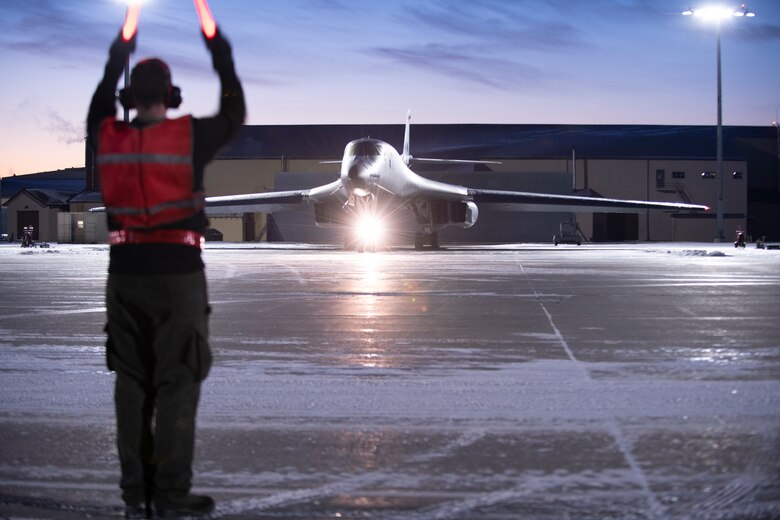
A maintainer assigned to the 28th Aircraft Maintenance Squadron marshals a B-1B Lancer assigned to the 34th Bomb Squadron prior to a Bomber Task Force mission from the continental United States, Nov. 12, 2020. U.S. Air Force maintainers are able to provide mission-ready strategic bombers, under any condition, at any time. (U.S. Air Force photo by Airman Jonah Fronk)
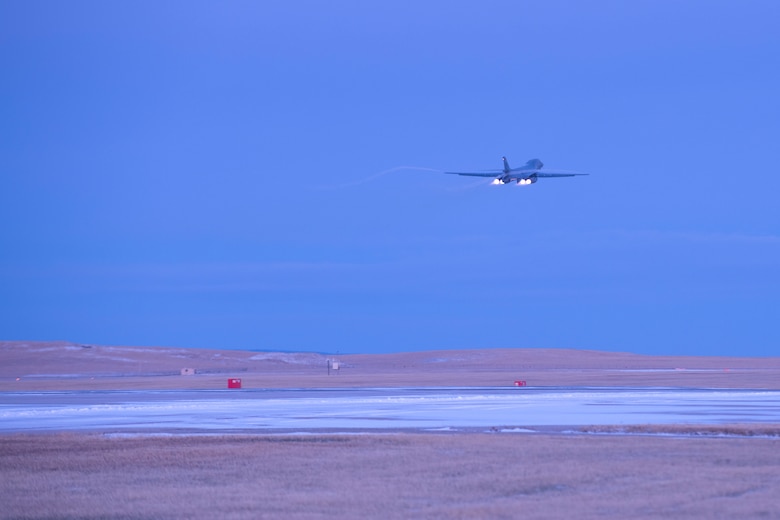
A B-1B Lancer assigned to the 34th Bomb Squadron takes off in support of a Bomber Task Force mission from the continental United States, Nov. 12, 2020. Bomber Task Force missions demonstrate how the Dynamic Force Employment Model enables strategic bombers to be anywhere on the globe at a moment's notice. (U.S. Air Force photo by Airman Jonah Fronk)
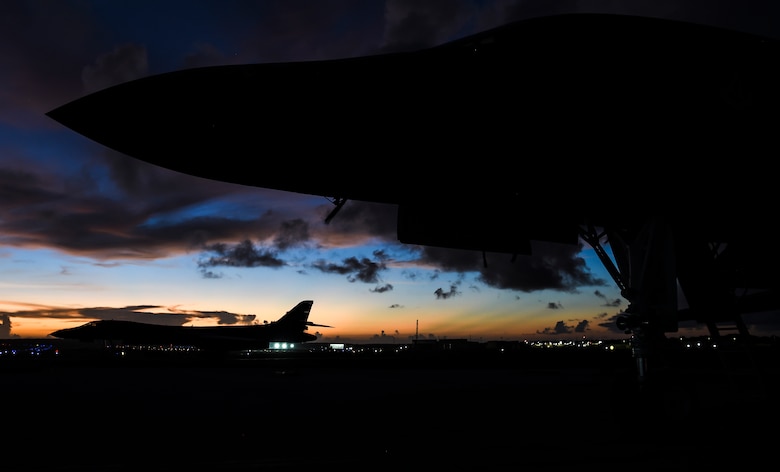
Two U.S. Air Force B-1B Lancers sit on the flightline after participating in a joint interoperability exercise at Andersen Air Force Base, Guam, Nov. 13, 2020. The exercise enabled the aircrew to test long-range force packaging and demonstrate global reach capabilities in the Indo-Pacific region. (U.S. Air Force photo by Staff Sgt. David Owsianka)
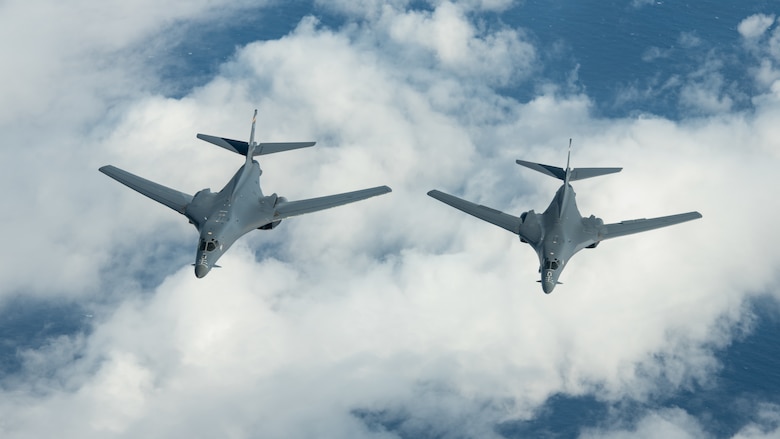
U.S. Air Force B-1B Lancers participate in a joint training exercise during a Bomber Task Force deployment, Nov. 13, 2020, over the Pacific Ocean. Bomber Task Force missions demonstrate U.S. commitment to allies and partners throughout the Indo-Pacific area of responsibility and the ability of Air Force Global Strike Command to deliver lethal strike options for combatant commanders at a moment's notice. (U.S. Air Force photo by Staff Sgt. Peter Reft)
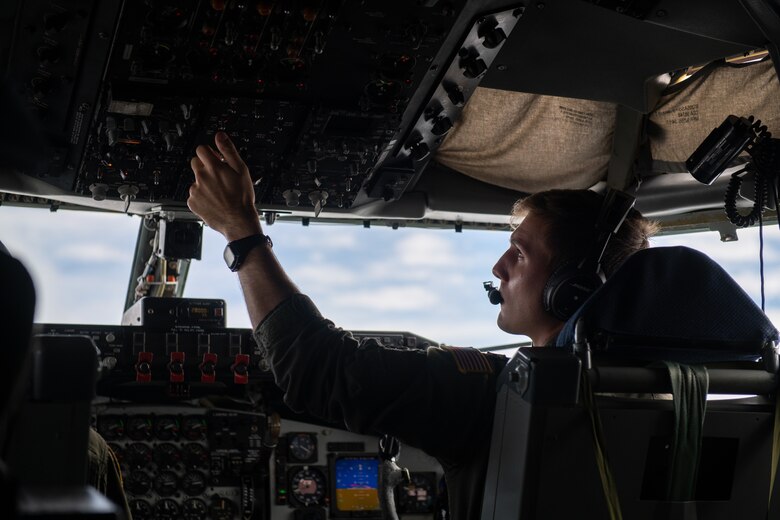
U.S. Air Force Capt. Dan Thomas, 909th Aerial Refueling Squadron KC-135 Stratotanker pilot, conducts aerial refueling operations in support of a joint interoperability exercise, Nov. 13, 2020, over the Pacific Ocean off the coast of Japan. Bomber Task Force missions demonstrate U.S. commitment to allies and partners throughout the Indo-Pacific area of responsibility and the ability of Air Force Global Strike Command to deliver lethal strike options for combatant commanders at a moment's notice. (U.S. Air Force photo by Staff Sgt. Peter Reft)
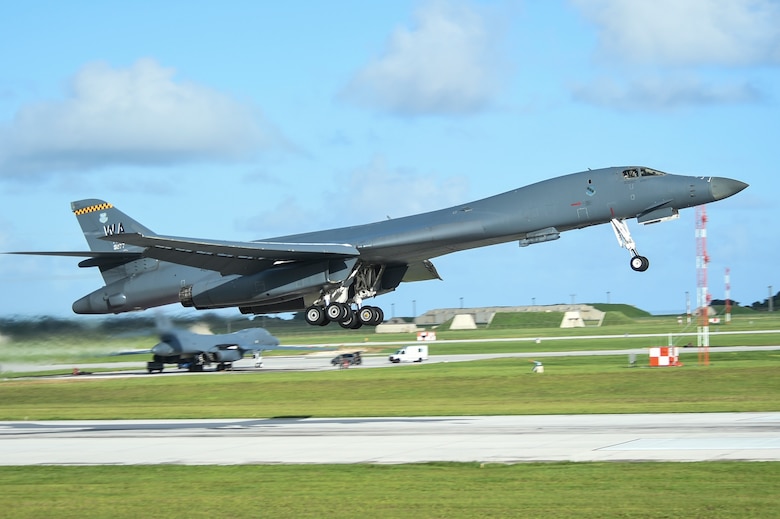
Aircrew with the 9th Expeditionary Bomb Squadron raise the landing gear of a U.S. Air Force B-1B Lancer during take-off in a joint interoperability exercise at Andersen Air Force Base, Guam, Nov. 13, 2020. Participating in the exercise allowed B-1 aircrews to obtain training that could be imperative in the future missions as they continue to stay committed to the security and stability of the Indo-Pacific region. (U.S. Air Force photo by Staff Sgt. David Owsianka)
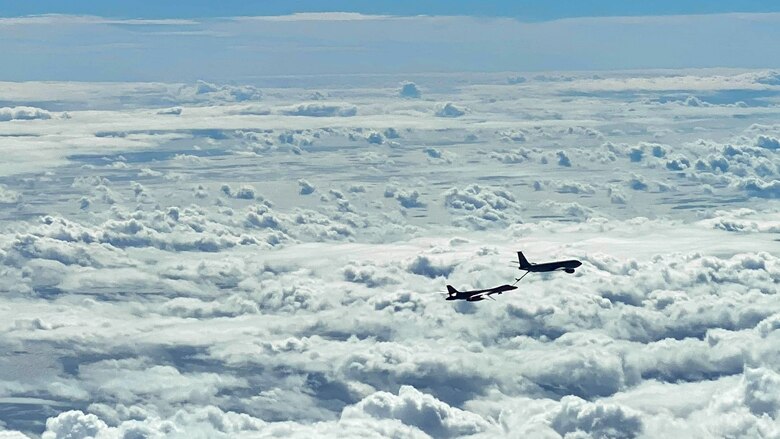
A U.S. Air Force B-1B Lancer and a 909th Aerial Refueling Squadron KC-135 Stratotanker, assigned to Kadena Air Base, Japan, conduct aerial refueling operations during a joint interoperability exercise, Nov. 13, 2020, over the Pacific Ocean. Bomber Task Force deployments demonstrate U.S. commitment to allies and partners and they train regularly with other units throughout the theater in order to maintain a free and open Indo-Pacific. (U.S. Air Force courtesy photo by 909th Aerial Refueling Squadron)

A U.S. Air Force B-1B Lancer receives fuel from a 909th Aerial Refueling Squadron KC-135 Stratotanker during a joint interoperability exercise, Nov. 13, 2020, over the Pacific Ocean. The B1-B Lancers are deployed as a Bomber Task Force which enables Airmen to continuously conduct operations throughout the world, maintain global stability and security, and familiarize units with joint and bilateral operations in different regions. (U.S. Air Force photo by Staff Sgt. Peter Reft)
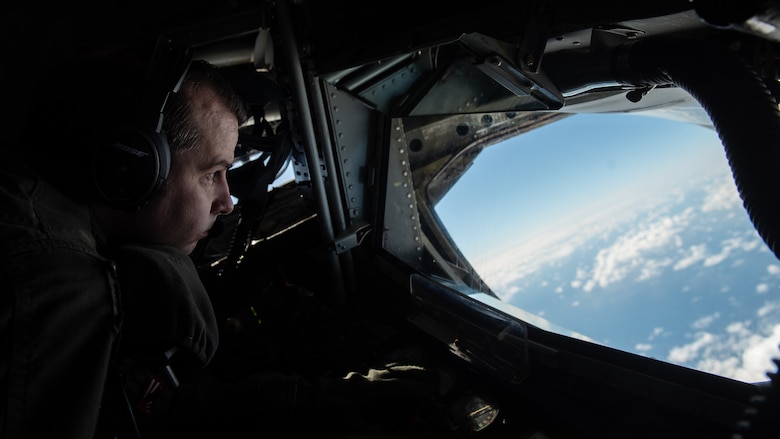
U.S. Air Force Tech. Sgt. Michael Weidman, 909th Aerial Refueling Squadron boom operator, scans the airspace for fuel receivers during a training sortie, Nov. 13, 2020, over the Pacific Ocean off the coast of Japan. The 909th ARS provided support to a B-1B Lancer Bomber Task Force mission, enabling deployed units to extend operational range, time on station, and integration throughout the U.S. Indo-Pacific Command area of responsibility. (U.S. Air Force photo by Staff Sgt. Peter Reft)






